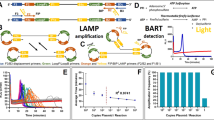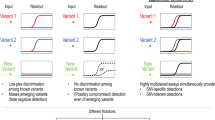Abstract
The exact quantification of tiny amounts of nucleic acids in biological samples continues to remain a requirement in both the experimental and the diagnostic laboratory. Competitive PCR involves the coamplification of a target DNA sample with known amounts of a competitor DNA that shares most of the nucleotide sequence with the target; in this way, any predictable or unpredictable variable affecting PCR amplification has the same effect on both molecular species. Competitive PCR therefore permits the quantification of the absolute number of target molecules in comparison to the amount of competitor DNA. Although requiring intensive post-PCR manipulation, the accuracy of competitive PCR by far exceeds that of any other quantitative PCR procedure, including real-time PCR. This protocol covers all stages in the competitive PCR and RT-PCR methods, from the design and construction of competitor molecules, and the competitive PCR itself, to the analysis of data and quantification of target DNA. Once the correct primers are available, the protocol can be completed in about 24 h.
This is a preview of subscription content, access via your institution
Access options
Subscribe to this journal
Receive 12 print issues and online access
$259.00 per year
only $21.58 per issue
Buy this article
- Purchase on Springer Link
- Instant access to full article PDF
Prices may be subject to local taxes which are calculated during checkout



Similar content being viewed by others
References
Arrigo, S.J., Weitsman, S., Rosenblatt, J.D. & Chen, I.S. Analysis of rev gene function on human immunodeficiency virus type 1 replication in lymphoid cells by using a quantitative polymerase chain reaction method. J. Virol. 63, 4875–4881 (1989).
Chelly, J., Concordet, J.P., Kaplan, J.C. & Kahn, A. Illegitimate transcription: transcription of any gene in any cell type. Proc. Natl. Acad. Sci. USA 86, 2617–2621 (1989).
Oka, S. et al. Quantitative analysis of human immunodeficiency virus type-1 DNA in asymptomatic carriers using the polymerase chain reaction. Biochem. Biophys. Res. Commun. 167, 1–8 (1990).
Simmonds, P. et al. Human immunodeficiency virus-infected individuals contain provirus in small numbers of peripheral mononuclear cells and at low copy numbers. J. Virol. 64, 864–872 (1990).
Livak, K.J., Flood, S.J., Marmaro, J., Giusti, W. & Deetz, K. Oligonucleotides with fluorescent dyes at opposite ends provide a quenched probe system useful for detecting PCR product and nucleic acid hybridization. PCR Methods Appl. 4, 357–362 (1995).
Gilliland, G., Perrin, S., Blanchard, K. & Bunn, H.F. Analysis of cytokine mRNA and DNA: detection and quantitation by competitive polymerase chain reaction. Proc. Natl. Acad. Sci. USA 87, 2725–2729 (1990).
Siebert, P.D. & Larrick, J.W. Competitive PCR. Nature 359, 557–558 (1992).
Becker-Andre, M. & Hahlbrock, K. Absolute mRNA quantification using the polymerase chain reaction (PCR). A novel approach by a PCR aided transcript titration assay (PATTY). Nucleic Acids Res. 17, 9437–9446 (1989).
Diviacco, S. et al. A novel procedure for quantitative polymerase chain reaction by coamplification of competitive templates. Gene 122, 313–320 (1992).
Celi, F.S., Zenilman, M.E. & Shuldiner, A.R. A rapid and versatile method to synthesize internal standards for competitive PCR. Nucleic Acids Res. 21, 1047 (1993).
Henco, K. & Heibey, M. Quantitative PCR: the determination of template copy numbers by temperature gradient gel electrophoresis (TGGE). Nucleic Acids Res. 18, 6733–6734 (1990).
Tani, H. et al. Quantitative method for specific nucleic acid sequences using competitive polymerase chain reaction with an alternately binding probe. Anal. Chem. 79, 974–979 (2007).
Giacca, M. et al. Fine mapping of a replication origin of human DNA. Proc. Natl. Acad. Sci. USA 91, 7119–7123 (1994).
Sestini, R. et al. Measuring c-erbB-2 oncogene amplification in fresh and paraffin-embedded tumors by competitive polymerase chain reaction. Clin. Chem. 40, 630–636 (1994).
Kato, K. et al. Cancer gene expression database (CGED): a database for gene expression profiling with accompanying clinical information of human cancer tissues. Nucleic Acids Res. 33, D533–D536 (2005).
Lusic, M., Marcello, A., Cereseto, A. & Giacca, M. Regulation of HIV-1 gene expression by histone acetylation and factor recruitment at the LTR promoter. EMBO J. 22, 6550–6561 (2003).
Deutsch, S. et al. Detection of aneuploidies by paralogous sequence quantification. J. Med. Genet. 41, 908–915 (2004).
Liu, W., James, C.D., Frederick, L., Alderete, B.E. & Jenkins, R.B. PTEN/MMAC1 mutations and EGFR amplification in glioblastomas. Cancer Res. 57, 5254–5257 (1997).
Comar, M. et al. Dynamics of HIV-1 mRNA expression in patients with long-term nonprogressive HIV-1 infection. J. Clin. Invest. 100, 893–903 (1997).
Grassi, G. et al. A rapid procedure for the quantitation of low abundance RNAs by competitive reverse transcription-polymerase chain reaction. Nucleic Acids Res. 22, 4547–4549 (1994).
Tafuro, S., Zentilin, L., Falaschi, A. & Giacca, M. Rapid retrovirus titration using competitive polymerase chain reaction. Gene Ther. 3, 679–684 (1996).
Mileham, K.A. et al. Competitive titration for probing low-abundance ion channel mRNA molecules in normal and regionally-ischaemic heart tissue. Mol. Cell. Probes 8, 161–176 (1994).
Nie, G.Y., Wang, J., Li, Y. & Salamonsen, L.A. Construction and application of a multispecific competitor to quantify mRNA of matrix metalloproteinases and their tissue inhibitors in small human biopsies. J. Biochem. Biophys. Methods 40, 81–99 (1999).
McCulloch, R.K., Choong, C.S. & Hurley, D.M. An evaluation of competitor type and size for use in the determination of mRNA by competitive PCR. PCR Methods Appl. 4, 219–226 (1995).
Serth, J., Panitz, F., Herrmann, H. & Alves, J. Single-tube nested competitive PCR with homologous competitor for quantitation of DNA target sequences: theoretical description of heteroduplex formation, evaluation of sensitivity, precision and linear range of the method. Nucleic Acids Res. 26, 4401–4408 (1998).
Giacca, M., Pelizon, C. & Falaschi, A. Mapping replication origins by quantifying relative abundance of nascent DNA strands using competitive polymerase chain reaction. Methods 13, 301–312 (1997).
Kato, K. Adaptor-tagged competitive PCR: a novel method for measuring relative gene expression. Nucleic Acids Res. 25, 4694–4696 (1997).
Kita-Matsuo, H. et al. Adaptor-tagged competitive polymerase chain reaction: amplification bias and quantified gene expression levels. Anal. Biochem. 339, 15–28 (2005).
Grove, S., Faller, R., Soleim, K.B. & Dannevig, B.H. Absolute quantitation of RNA by a competitive real-time RT-PCR method using piscine nodavirus as a model. J. Virol. Methods 132, 104–112 (2006).
Locatelli, G. et al. Real-time quantitative PCR for human herpesvirus 6 DNA. J. Clin. Microbiol. 38, 4042–4048 (2000).
Widada, J. et al. Quantification of the carbazole 1,9a-dioxygenase gene by real-time competitive PCR combined with co-extraction of internal standards. FEMS Microbiol. Lett. 202, 51–57 (2001).
Ding, C. & Cantor, C.R. A high-throughput gene expression analysis technique using competitive PCR and matrix-assisted laser desorption ionization time-of-flight MS. Proc. Natl. Acad. Sci. USA 100, 3059–3064 (2003).
Ding, C. & Cantor, C.R. Quantitative analysis of nucleic acids—the last few years of progress. J. Biochem. Mol. Biol. 37, 1–10 (2004).
McCullough, R.M., Cantor, C.R. & Ding, C. High-throughput alternative splicing quantification by primer extension and matrix-assisted laser desorption/ionization time-of-flight mass spectrometry. Nucleic Acids Res. 33, e99 (2005).
Elvidge, G.P., Price, T.S., Glenny, L. & Ragoussis, J. Development and evaluation of real competitive PCR for high-throughput quantitative applications. Anal. Biochem. 339, 231–241 (2005).
Ausubel, F.M. et al. Current Protocols in Molecular Biology (J. Wiley & Sons Inc., New York, NY, 2003).
Sambrook, J., Fritsch, E.F. & Maniatis, T. Molecular Cloning. A Laboratory Manual 2nd edn. (Cold Spring Harbor Laboratory, Cold Spring Harbor, NY, 1989).
Author information
Authors and Affiliations
Corresponding author
Ethics declarations
Competing interests
The authors declare no competing financial interests.
Rights and permissions
About this article
Cite this article
Zentilin, L., Giacca, M. Competitive PCR for precise nucleic acid quantification. Nat Protoc 2, 2092–2104 (2007). https://doi.org/10.1038/nprot.2007.299
Published:
Issue Date:
DOI: https://doi.org/10.1038/nprot.2007.299
This article is cited by
-
TP53 mutation prevalence in normal airway epithelium as a biomarker for lung cancer risk
BMC Cancer (2023)
-
Development of plasmid calibrators for absolute quantification of the β-parvalbumin gene in Lophius piscatorius
European Food Research and Technology (2023)
-
A Reliable Method for Quantifying Plasma Cell-Free DNA Using an Internal Standard Strategy: Evaluation in a Cohort of Non-Pregnant and Pregnant Women
Reproductive Sciences (2023)
-
IMPLANT: a new technique for transgene copy number estimation in plants using a single end-point PCR reaction
Plant Methods (2022)
-
Technical advance in targeted NGS analysis enables identification of lung cancer risk-associated low frequency TP53, PIK3CA, and BRAF mutations in airway epithelial cells
BMC Cancer (2019)
Comments
By submitting a comment you agree to abide by our Terms and Community Guidelines. If you find something abusive or that does not comply with our terms or guidelines please flag it as inappropriate.



